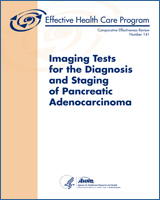From: Introduction

NCBI Bookshelf. A service of the National Library of Medicine, National Institutes of Health.
| KQ | Population | Interventions | Comparators | Outcomes |
|---|---|---|---|---|
| 1a | P1 | MDCT, MDCT angiography, EUS-FNA, PET/CT, or MRI | None | Diagnostic accuracy as determined by surgical findings and/or clinical followup Accuracy of resectability judgment |
| 1b | P1 | Same list of interventions as for KQ1a | Another test from the list of interventions as for KQ1a | Diagnostic accuracy as determined by surgical findings and/or clinical followup Accuracy of resectability judgment |
| 1c | P1 | Single imaging test: Same list of interventions as for KQ1a | Multiple tests from the list of interventions as for KQ1a | Diagnostic accuracy as determined by surgical findings and/or clinical followup |
| 1d | P1 | 1 test: High vs. low experience | Another test: High vs. Low experience | Diagnostic accuracy as determined by surgical findings and/or clinical followup |
| 1e | P1 | Patient factors or tumor characteristics | Comparator patient factor (e.g., age) or tumor characteristic (e.g., head or tail of pancreas) | Diagnostic accuracy as determined by surgical findings and/or clinical followup |
| 1f | P1 | Same list of interventions as for KQ1a | Same list of interventions as for KQ1a | Clinical management (e.g., the percentage of patients in whom resection is attempted) |
| 1g | P1 | Same list of interventions as for KQ1a | Same list of interventions as for KQ1a | Overall survival (minimum 1 year followup) Pancreatic adenocarcinoma-specific survival (minimum 1 year followup) Quality of life (e.g., SF-36) (minimum 1 year followup) |
| 2a | P2 | Same list of interventions as for KQ1a | None | Staging accuracy as determined by surgical findings and/or clinical followup:
|
| 2b | P2 | Same list of interventions as for KQ1a | Another test from the list of interventions as for KQ1a | Staging accuracy as determined by surgical findings and/or clinical followup (same list as above) |
| 2c | P2 | Single imaging test: Same list of interventions as for KQ1a | Multiple imaging tests: Same list of interventions as for KQ1a | Staging accuracy as determined by surgical findings and/or clinical followup (same list as above) |
| 2d | P2 | 1 test: High vs. low experience | Another test: High vs. Low experience | Staging accuracy as determined by surgical findings and/or clinical followup (same list as above) |
| 2e | P2 | 1 test: Effect of patient factor or tumor characteristic | Another test: Effect of patient factor or tumor characteristic | Staging accuracy as determined by surgical findings and/or clinical followup (same list as above) |
| 2f | P2 | Same list of interventions as for KQ1a | Same list of interventions as for KQ1a | Clinical management (e.g., the percentage of patients in whom resection is attempted) |
| 2g | P2 | Same list of interventions as for KQ1a | Same list of interventions as for KQ1a | Overall survival (minimum 1 year followup) Pancreatic adenocarcinoma-specific survival (minimum 1 year followup) Quality of life (e.g., SF-36) (minimum 1 year followup) |
| 3 | P1 or P2 or P3 | Same list of interventions as for KQ1a | None | Radiation from MDCT (e.g., carcinogenic effects) Adverse reactions to contrast agents Adverse reaction to radiopharmaceuticals Pancreatitis from EUS-FNA Perforation or bleeding from EUS-FNA. Sedation-related effects of EUS-FNA (e.g., nausea, vomiting) |
| 3a | P1 or P2 or P3 | Patient factor | Comparator patient factor | See above list of harms |
| 3b | P1 or P2 or P3 | Same list of interventions as for KQ1a | Any | Patient perspectives on imaging techniques, including tolerance, satisfaction, preference, and balance of benefits and harms |
| 4 | P3 | Same list of interventions as for KQ1a | Same list of interventions as for KQ1a | Screening accuracy as determined by surgical findings and/or clinical followup |
Note: Population P1 is symptomatic patients being assessed for possible pancreatic adenocarcinoma; population P2 is adults with known pancreatic adenocarcinoma; population P3 is asymptomatic adults at high risk of developing pancreatic adenocarcinoma. High risk encompasses those with either a genetic or familial risk such as having two or more first-degree relatives with pancreatic cancer; three or more blood relatives, one of whom is a first-degree relative; or in addition to having a first-degree relative with pancreatic cancer, having Peutz-Jeghers syndrome, Lynch syndrome, or BRCA2, PALB2, or p16 gene mutations.
From: Introduction

NCBI Bookshelf. A service of the National Library of Medicine, National Institutes of Health.